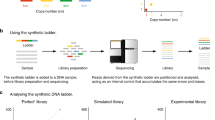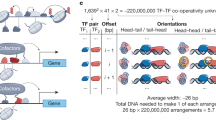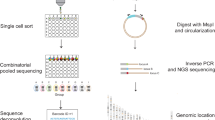Abstract
Experimental genomics in combination with the growing body of sequence information promise to revolutionize the way cells and cellular processes are studied. Information on genomic sequence can be used experimentally with high-density DNA arrays that allow complex mixtures of RNA and DNA to be interrogated in a parallel and quantitative fashion. DNA arrays can be used for many different purposes, most prominently to measure levels of gene expression (messenger RNA abundance) for tens of thousands of genes simultaneously. Measurements of gene expression and other applications of arrays embody much of what is implied by the term ‘genomics’; they are broad in scope, large in scale, and take advantage of all available sequence information for experimental design and data interpretation in pursuit of biological understanding.
This is a preview of subscription content, access via your institution
Access options
Subscribe to this journal
Receive 51 print issues and online access
$199.00 per year
only $3.90 per issue
Buy this article
- Purchase on Springer Link
- Instant access to full article PDF
Prices may be subject to local taxes which are calculated during checkout





Similar content being viewed by others
References
Dunham, I. et al. The DNA sequence of human chromosome 22. Nature 402, 489–495 (1999).
Hattori, M. et al. The DNA sequence of human chromosome 21. Nature 405, 311–319 ( 2000).
Lennon, G. G. & Lehrach, H. Hybridization analyses of arrayed cDNA libraries. Trends Genet. 7, 314– 317 (1991).
Kafatos, F. C., Jones, C. W. & Efstratiadis, A. Determination of nucleic acid sequence homologies and relative concentrations by a dot hybridization procedure. Nucleic Acids Res. 7, 1541–1552 (1979).
Gillespie, D. & Spiegelman, S. A quantitative assay for DNA-RNA hybrids with DNA immobilized on a membrane. J. Mol. Biol. 12, 829–842 (1965).
Southern, E. M. et al. Arrays of complementary oligonucleotides for analysing the hybridisation behaviour of nucleic acids. Nucleic Acids Res. 22, 1368–1373 (1994).
Zhao, N., Hashida, H., Takahashi, N., Misumi, Y. & Sakaki, Y. High-density cDNA filter analysis: a novel approach for large-scale, quantitative analysis of gene expression . Gene 156, 207–213 (1995).
Nguyen, C. et al. Differential gene expression in the murine thymus assayed by quantitative hybridization of arrayed cDNA clones. Genomics 29, 207–216 (1995).
Fodor, S. P. A. et al. Light-directed, spatially addressable parallel chemical synthesis . Science 251, 767–773 (1991).
Fodor, S. P. et al. Multiplexed biochemical assays with biological chips. Nature 364, 555–556 ( 1993).
Pease, A. C. et al. Light-generated oligonucleotide arrays for rapid DNA sequence analysis. Proc. Natl Acad. Sci. USA 91, 5022–5026 (1994).
Schena, M., Shalon, D., Davis, R. W. & Brown, P. O. Quantitative monitoring of gene expression patterns with a complementary DNA microarray . Science 270, 467–470 (1995).
Shalon, D., Smith, S. J. & Brown, P. O. A DNA microarray system for analyzing complex DNA samples using two-color fluorescent probe hybridization. Genome Res. 6, 639–645 ( 1996).
DeRisi, J. L., Iyer, V. R. & Brown, P. O. Exploring the metabolic and genetic control of gene expression on a genomic scale. Science 278, 680–686 (1997).
Lipshutz, R. J., Fodor, S. P., Gingeras, T. R. & Lockhart, D. J. High density synthetic oligonucleotide arrays. Nature Genet. 21, 20–24 (1999).
Bowtell, D. D. Options available—from start to finish—for obtaining expression data by microarray. Nature Genet. 21, 25 –32 (1999).
Edman, C. F. et al. Electric field directed nucleic acid hybridization on microchips . Nucleic Acids Res. 25, 4907– 4914 (1997).
Sosnowski, R. G., Tu, E., Butler, W. F., O'Connell, J. P. & Heller, M. J. Rapid determination of single base mismatch mutations in DNA hybrids by direct electric field control. Proc. Natl Acad. Sci. USA 94, 1119–1123 ( 1997).
Gray, D. E., Case-Green, S. C., Fell, T. S., Dobson, P. J. & Southern, E. M. Ellipsometric and interferometric characterization of DNA probes immobilised on a combinatorial array. Langmuir 13, 2833–2842 ( 1997).
Walt, D. R. Bead-based fiber-optic arrays. Science 287, 451 (2000).
Michael, K. L., Taylor, L. C., Schultz, S. L. & Walt, D. R. Randomly ordered addressable high-density optical sensor arrays. Anal. Chem. 70, 1242–1248 (1998).
Ferguson, J. A., Boles, T. C., Adams, C. P. & Walt, D. R. A fiber-optic DNA biosensor microarray for the analysis of gene expression . Nature Biotechnol. 14, 1681– 1684 (1996).
Spellman, P. T. et al. Comprehensive identification of cell cycle-regulated genes of the yeast Saccharomyces cerevisiae by microarray hybridization. Mol. Biol. Cell 9, 3273–3297 (1998).
Cho, R. J. et al. A genome-wide transcriptional analysis of the mitotic cell cycle. Mol. Cell 2, 65– 73 (1998).
The Chipping forecast. Nature Genet. 21(Suppl.), 1–60 ( 1999).
Wodicka, L., Dong, H., Mittmann, M., Ho, M.-H & Lockhart, D. J. Genome-wide expression monitoring in Saccharomyces cerevisiae. Nature Biotechnol. 15, 1359 –1367 (1997).
White, K. P., Rifkin, S. A., Hurban, P. & Hogness, D. S. Microarray analysis of Drosophila development during metamorphosis . Science 286, 2179–2184 (1999).
Chambers, J. et al. DNA microarrays of the complex human cytomegalovirus genome: profiling kinetic class with drug sensitivity of viral gene expression. J. Virol. 73, 5757–5766 (1999).
Gingeras, T. R. et al. Simultaneous genotyping and species identification using hybridization pattern recognition analysis of generic mycobacterium DNA arrays. Genome Res. 8, 435–448 ( 1998).
Lockhart, D. J. et al. Expression monitoring by hybridization to high-density oligonucleotide arrays. Nature Biotechnol. 14, 1675– 1680 (1996).
Liang, P. & Pardee, A. B. Differential display of eukaryotic messenger RNA by means of the polymerase chain reaction. Science 257, 967–971 ( 1992).
Shimkets, R. A. et al. Gene expression analysis by transcript profiling coupled to a gene database query. Nature Biotechnol. 17, 798–803 (1999).
Ivanova, N. B. & Belyavsky, A. V. Identification of differentially expressed genes by restriction endonuclease-based gene expression fingerprinting. Nucleic Acids Res. 23, 2954 –2958 (1995).
Kato, K. Description of the entire mRNA population by a 3′ end cDNA fragment generated by class IIS restriction enzymes. Nucleic Acids Res. 23, 3685–3690 ( 1995).
Bachem, C. W. et al. Visualization of differential gene expression using a novel method of RNA fingerprinting based on AFLP: analysis of gene expression during potato tuber development. Plant J. 9, 745 –753 (1996).
Velculescu, V. E., Zhang, L., Vogelstein, B. & Kinzler, K. W. Serial analysis of gene expression. Science 270, 484–487 (1995).
Boucherie, H. et al. Two-dimensional protein map of Saccharomyces cerevisiae : construction of a gene-protein index. Yeast 11 , 601–613 (1995).
Gygi, S. P. et al. Quantitative analysis of complex protein mixtures using isotope-coded affinity tags. Nature Biotechnol. 17, 994 –999 (1999).
Mann, M. Quantitative proteomics? Nature Biotechnol. 17, 954–955 (1999).
Oda, Y., Huang, K., Cross, F. R., Cowburn, D. & Chait, B. T. Accurate quantitation of protein expression and site-specific phosphorylation. Proc. Natl Acad. Sci. USA 96, 6591–6596 (1999).
Burns, N. et al. Large-scale analysis of gene expression, protein localization, and gene disruption in Saccharomyces cerevisiae. Genes Dev. 8, 1087–1105 (1994).
Ross-Macdonald, P., Sheehan, A., Roeder, G. S. & Snyder, M. A multipurpose transposon system for analyzing protein production, localization, and function in Saccharomyces cerevisiae. Proc. Natl Acad. Sci. USA 94, 190–195 ( 1997).
Ross-Macdonald, P. et al. Large-scale analysis of the yeast genome by transposon tagging and gene disruption. Nature 402, 413– 418 (1999).
Niedenthal, R. K., Riles, L., Johnston, M. & Hegemann, J. H. Green fluorescent protein as a marker for gene expression and subcellular localization in budding yeast. Yeast 12, 773–786 (1996).
Zong, Q., Schummer, M., Hood, L. & Morris, D. R. Messenger RNA translation state: the second dimension of high-throughput expression screening . Proc. Natl Acad. Sci. USA 96, 10632– 10636 (1999).
Johannes, G., Carter, M. S., Eisen, M. B., Brown, P. O. & Sarnow, P. Identification of eukaryotic mRNAs that are translated at reduced cap binding complex eIF4F concentrations using a cDNA microarray. Proc. Natl Acad. Sci. USA 96, 13118–13123 (1999).
Diehn, M., Eisen, M. B., Botstein, D. & Brown, P. O. Large-scale identification of secreted and membrane-associated gene products using DNA microarrays. Nature Genet. 25, 58–62 (2000).
Weinstein, J. N. Fishing expeditions. Science 282, 628– 629 (1998).
Golub, T. R. et al. Molecular classification of cancer: class discovery and class prediction by gene expression monitoring. Science 286 , 531–537 (1999).
Alizadeh, A. A. et al. Distinct types of diffuse large B-cell lymphoma identified by gene expression profiling. Nature 403, 503–510 (2000).
Mack, D. H. et al. in Deciphering Molecular Circuitry Using High-Density DNA Arrays (eds Hihich, E. & Croce, E.) 85–108 (Plenum, New York, 1998).
Alon, U. et al. Broad patterns of gene expression revealed by clustering analysis of tumor and normal colon tissues probed by oligonucleotide arrays. Proc. Natl Acad. Sci. USA 96, 6745– 6750 (1999).
Perou, C. M. et al. Distinctive gene expression patterns in human mammary epithelial cells and breast cancers. Proc. Natl Acad. Sci. USA 96, 9212–9217 (1999).
Ross, D. T. et al. Systematic variation in gene expression patterns in human cancer cell lines. Nature Genet. 24, 227 –235 (2000).
Scherf, U. et al. A gene expression database for the molecular pharmacology of cancer. Nature Genet. 24, 236– 244 (2000).
Fambrough, D., McClure, K., Kazlauskas, A. & Lander, E. S. Diverse signaling pathways activated by growth factor receptors induce broadly overlapping, rather than independent, sets of genes. Cell 97, 727–741 (1999).
Lee, S. B. et al. The Wilms tumor suppressor WT1 encodes a transcriptional activator of amphiregulin. Cell 98, 663– 673 (1999).
Harkin, D. P. et al. Induction of GADD45 and JNK/SAPK-dependent apoptosis following inducible expression of BRCA1. Cell 97, 575–586 (1999).
Mei, R. et al. Genome-wide detection of allelic imbalance using human SNPs and high density DNA arrays. Genome Res. (in the press).
Pollack, J. R. et al. Genome-wide analysis of DNA copy-number changes using cDNA microarrays. Nature Genet. 23, 41– 46 (1999).
Pinkel, D. et al. High resolution analysis of DNA copy number variation using comparative genomic hybridization to microarrays. Nature Genet. 20, 207–211 ( 1998).
Holstege, F. C. et al. Dissecting the regulatory circuitry of a eukaryotic genome . Cell 95, 717–728 (1998).
Wyrick, J. J. et al. Chromosomal landscape of nucleosome-dependent gene expression and silencing in yeast. Nature 402, 418– 421 (1999).
Tamayo, P. et al. Interpreting patterns of gene expression with self-organizing maps: methods and application to hematopoietic differentiation. Proc. Natl Acad. Sci. USA 96, 2907– 2912 (1999).
Eisen, M. B., Spellman, P. T., Brown, P. O. & Botstein, D. Cluster analysis and display of genome-wide expression patterns. Proc. Natl Acad. Sci. USA 95, 14863– 14868 (1998).
Wen, X. et al. Large-scale temporal gene expression mapping of central nervous system development. Proc. Natl Acad. Sci. USA 95, 334–339 (1998).
Chu, S. et al. The transcriptional program of sporulation in budding yeast. Science 282, 699–705 ( 1998).
Tavazoie, S., Hughes, J. D., Campbell, M. J., Cho, R. J. & Church, G. M. Systematic determination of genetic network architecture. Nature Genet. 22, 281–285 (1999).
Wolfsberg, T. G. et al. Candidate regulatory sequence elements for cell cycle-dependent transcription in Saccharomyces cerevisiae. Genome Res. 9, 775–792 (1999).
Marton, M. J. et al. Drug target validation and identification of secondary drug target effects using DNA microarrays. Nature Med. 4 , 1293–1301 (1998).
Gray, N. S. et al. Exploiting chemical libraries, structure, and genomics in the search for kinase inhibitors. Science 281, 533–538 (1998).
Rosania, G. R. et al. Myoseverin: a microtubule binding molecule with novel cellular effects. Nature Biotechnol. 18, 304– 308 (2000).
Emmert-Buck, M. R. et al. Laser capture microdissection. Science 274, 998–1001 (1996).
Bonner, R. F. et al. Laser capture microdissection: molecular analysis of tissue . Science 278, 1481–1483 (1997).
Simone, N. L., Bonner, R. F., Gillespie, J. W., Emmert-Buck, M. R. & Liotta, L. A. Laser-capture microdissection: opening the microscopic frontier to molecular analysis. Trends Genet. 14, 272–276 (1998).
Wang, A. M., Doyle, M. V. & Mark, D. F. Quantitation of mRNA by the polymerase chain reaction . Proc. Natl Acad. Sci. USA 86, 9717– 9721 (1989).
Dulac, C. Cloning of genes from single neurons. Curr. Top. Dev. Biol. 36, 245–258 (1998).
Jena, P. K., Liu, A. H., Smith, D. S. & Wysocki, L. J. Amplification of genes, single transcripts and cDNA libraries from one cell and direct sequence analysis of amplified products derived from one molecule. J. Immunol. Methods 190, 199–213 ( 1996).
Kwoh, D. Y. et al. Transcription-based amplification system and detection of amplified human immunodeficiency virus type 1 with a bead-based sandwich hybridization format. Proc. Natl Acad. Sci. USA 86, 1173 –1177 (1989).
Guatelli, J. C. et al. Isothermal, in vitro amplification of nucleic acids by a multienzyme reaction modeled after retroviral replication. Proc. Natl Acad. Sci. USA 87, 7797 (1990).
Eberwine, J. et al. Analysis of gene expression in single live neurons. Proc. Natl Acad. Sci. USA 89, 3010– 3014 (1992).
Luo, L. et al. Gene expression profiles of laser-captured adjacent neuronal subtypes . Nature Med. 5, 117–122 (1999).
Cho, R. J. et al. Parallel analysis of genetic selections using whole genome oligonucleotide arrays. Proc. Natl Acad. Sci. USA 95 , 3752–3757 (1998).
Bulyk, M. L., Gentalen, E., Lockhart, D. J. & Church, G. M. Quantifying DNA-protein interactions by double-stranded DNA arrays. Nature Biotechnol. 17, 573–577 (1999).
Brent, R. Genomic biology. Cell 100, 169– 183 (2000).
McAdams, H. H. & Shapiro, L. Circuit simulation of genetic networks. Science 269, 650– 656 (1995).
McAdams, H. H. & Arkin, A. It's a noisy business! Genetic regulation at the nanomolar scale. Trends Genet. 15, 65–69 (1999).
Bhalla, U. S. & Iyengar, R. Emergent properties of networks of biological signaling pathways. Science 283, 381–387 (1999).
Weng, G., Bhalla, U. S. & Iyengar, R. Complexity in biological signaling systems. Science 284, 92–96 ( 1999).
Arkin, A., Ross, J. & McAdams, H. H. Stochastic kinetic analysis of developmental pathway bifurcation in phage lambda-infected Escherichia coli cells. Genetics 149, 1633–1648 (1998).
Winzeler, E. et al. Functional characterization of the Saccharomyces cerevisiae genome by precise deletion and parallel analysis. Science 285, 901–906 ( 1999).
Fields, S. & Song, O. A novel genetic system to detect protein–protein interactions. Nature 340, 245– 246 (1989).
Roberts, C. J. et al. Signaling and circuitry of multiple MAPK pathways revealed by a matrix of global gene expression profiles. Science 287, 873–880 (2000).
Brown, P. O. & Botstein, D. Exploring the new world of the genome with DNA microarrays. Nature Genet. 21, 33–37 (1999).
Ly, D., Lockhart, D. J., Lerner, R. & Schultz, P. G. Mitotic misregulation and human aging. Science 287, 2486–22492 (2000).
Cherry, J. M. et al. Genetic and physical maps of Saccharomyces cerevisiae. Nature 387, 67–73 ( 1997).
Ball, C. A. et al. Integrating functional genomic information into the Saccharomyces Genome Database. Nucleic Acids Res. 28, 77–80 (2000).
Mewes, H. W. et al. MIPS: a database for genomes and protein sequences. Nucleic Acids Res. 28, 37–40 (2000).
Walsh, S., Anderson, M. & Cartinhour, S. W. ACEDB: a database for genome information. Methods Biochem. Anal. 39, 299–318 (1998).
Kanehisa, M. & Goto, S. KEGG: Kyoto Encyclopedia of Genes and Genomes. Nucleic Acids Res. 28, 27– 30 (2000).
The FlyBase Consortium. The FlyBase Database of the Drosophila Genome Projects and community literature. Nucleic Acids Res. 27, 85–88 ( 1999).
Karp, P. D., Riley, M., Paley, S. M., Pellegrini-Toole, A. & Krummenacker, M. EcoCyc: encyclopedia of Escherichia coli genes and metabolism. Nucleic Acids Res. 27 , 50–53 (1999).
Iyer, V. & Struhl, K. Absolute mRNA levels and transcriptional initiation rates in Saccharomyces cerevisiae. Proc. Natl Acad. Sci. USA 93, 5208–5212 (1996).
Lee, C. K., Klopp, R. G., Weindruch, R. & Prolla, T. A. Gene expression profile of aging and its retardation by caloric restriction . Science 285, 1390–1393 (1999).
Fan, J.-B et al. Parallel genotyping of human SNPs using generic oligonucleotide tag arrays. Genome Res. (in the press).
Lashkari, D. A. et al. Yeast microarrays for genome wide parallel genetic and gene expression analysis. Proc. Natl Acad. Sci. USA 94, 13057–13062 (1997).
Winzeler, E., Lee, B., McCusker, J. & Davis, R. Whole genome genetic typing using high-density oligonucleotide arrays. Parasitology 118, S73–S80 ( 1999).
Winzeler, E. A. et al. Direct allelic variation scanning of the yeast genome. Science 281, 1194–1197 ( 1998).
Troesch, A. et al. Mycobacterium species identification and rifampin resistance testing with high-density DNA probe arrays. J. Clin. Microbiol. 37, 49–55 ( 1999).
Acknowledgements
We thank S. Fodor, M. Chee, R. Davis, L. Stryer, E. Lander, H. Dong, L. Wodicka, R. Cho, D. Giang, P. Zarrinkar, C. Barlow, J. Gentry, P. Schultz and R. Abagyan for their on-going help and patience, and B. Geierstanger, G. Hampton and S. Kay for helpful comments and a critical reading of the manuscript.
Author information
Authors and Affiliations
Rights and permissions
About this article
Cite this article
Lockhart, D., Winzeler, E. Genomics, gene expression and DNA arrays. Nature 405, 827–836 (2000). https://doi.org/10.1038/35015701
Issue Date:
DOI: https://doi.org/10.1038/35015701
This article is cited by
-
Interpretable predictions of chaotic dynamical systems using dynamical system deep learning
Scientific Reports (2024)
-
Reveal key genes and factors affecting athletes performance in endurance sports using bioinformatic technologies
BMC Genomic Data (2023)
-
Differentially expression analyses in fruit of cultivated and wild species of grape and peach
Scientific Reports (2023)
-
Technical assessment of different extraction methods and transcriptome profiling of RNA isolated from small volumes of blood
Scientific Reports (2023)
-
A proficient two stage model for identification of promising gene subset and accurate cancer classification
International Journal of Information Technology (2023)
Comments
By submitting a comment you agree to abide by our Terms and Community Guidelines. If you find something abusive or that does not comply with our terms or guidelines please flag it as inappropriate.




